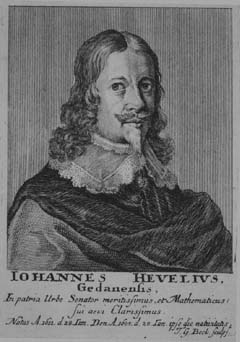Danzig Notables -- Johann Hevelius

Johann Hevelius was born in Danzig in 1611. After graduating from the Gymnasium there he studied law in Leiden. In 1631 he began his travels to London, Paris, Avignon, Germany and Switzerland and grew increasingly interested in astronomy. Upon returning to Danzig in 1634 he took up the profitable occupation of beer brewing for five years, but his former teacher, Peter Krüger, succeeded in luring him into astronomical studies. An eclipse of the sun which sent his compatriots into panic also helped convince him of the importance of astronomical studies. Gradually his wealth was used to acquire a fine Dutch printing press, an etching studio, and lens manufacture, all in support of his studies of the heavens. In 1647 he published Selenographia, a description of the moon with 112 engravings. This established his reputation throughout Europe. In 1650 he built an observatory, following the model of Danish astronomer Tycho de Brahe, on the roofs of three houses in Danzig. This became the most important observatory in Europe. Scholars and princes came to Danzig to visit it. Hevelius invented a pendulum before Huyghens, discovered lunar libration, and closely observed comets. At age 52 Hevelius entered a second marriage with the 16 year-old daughter of a local merchant, Catharina Elisabeth Koopmann. She became his assistant and, after his death in 1687, edited three of his works.
Although the Royal Society of England sent Edmund Halley to Danzig to inspect the great telescope of Hevelius ( 48 meters long) in 1713, it seems unlikely that the observatory was still there for Luise Kulmus to visit. But her interest in the heavens may have originated with accounts of them from her youth in Danzig. His interest in empirical science influenced others in this direction, including the botanist, Johann Breyne.
[Hans-Jürgen Kämpfert. Danziger Naturwissenschaftler. Ein überblick vom ausgehenden Mittelalter bis zum 19. Jahrhundert. In Danzig in acht Jahrhunderten. Ed. Bernhart Jähnig und Peter Letkemann. Münster: Nicolaus-Copernicus Verlag. 1985. S. 185-211]